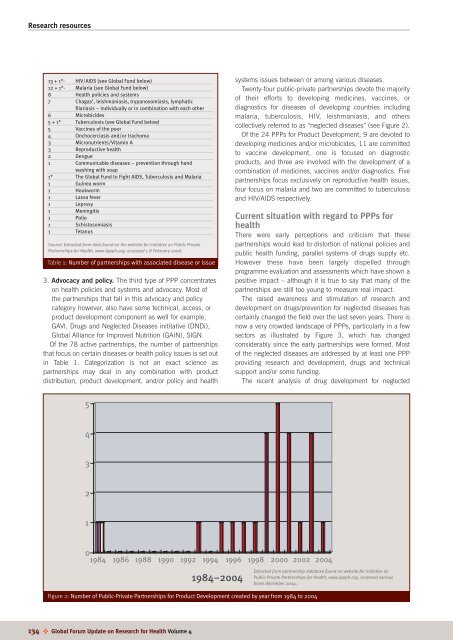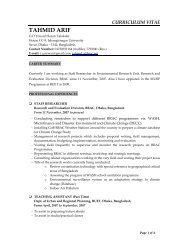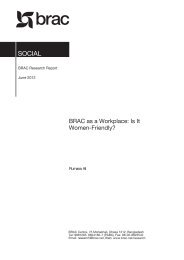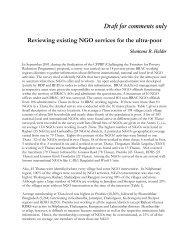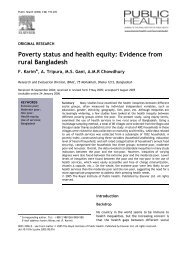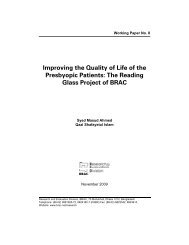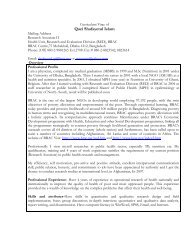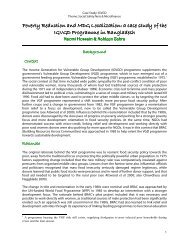Combining health and social protection measures to reach the ultra ...
Combining health and social protection measures to reach the ultra ...
Combining health and social protection measures to reach the ultra ...
You also want an ePaper? Increase the reach of your titles
YUMPU automatically turns print PDFs into web optimized ePapers that Google loves.
Research resources<br />
13 + 1*- HIV/AIDS (see Global Fund below)<br />
12 + 1*- Malaria (see Global Fund below)<br />
8 Health policies <strong>and</strong> systems<br />
7 Chagas’, leishmaniasis, trypanosomiasis, lymphatic<br />
filariasis – individually or in combination with each o<strong>the</strong>r<br />
6 Microbicides<br />
5 + 1* Tuberculosis (see Global Fund below)<br />
5 Vaccines of <strong>the</strong> poor<br />
4 Onchocerciasis <strong>and</strong>/or trachoma<br />
3 Micronutrients/Vitamin A<br />
3 Reproductive <strong>health</strong><br />
2 Dengue<br />
1 Communicable diseases – prevention through h<strong>and</strong><br />
washing with soap<br />
1* The Global Fund <strong>to</strong> Fight AIDS, Tuberculosis <strong>and</strong> Malaria<br />
1 Guinea worm<br />
1 Hookworm<br />
1 Lassa fever<br />
1 Leprosy<br />
1 Meningitis<br />
1 Polio<br />
1 Schis<strong>to</strong>somiasis<br />
1 Tetanus<br />
Source: Extracted from data found on <strong>the</strong> website for Initiative on Public Private<br />
Partnerships for Health, www.ippph.org, accessed 1-8 February 2006.<br />
Table 1: Number of partnerships with associated disease or issue<br />
3. Advocacy <strong>and</strong> policy. The third type of PPP concentrates<br />
on <strong>health</strong> policies <strong>and</strong> systems <strong>and</strong> advocacy. Most of<br />
<strong>the</strong> partnerships that fall in this advocacy <strong>and</strong> policy<br />
category however, also have some technical, access, or<br />
product development component as well for example,<br />
GAVI, Drugs <strong>and</strong> Neglected Diseases inititative (DNDi),<br />
Global Alliance for Improved Nutrition (GAIN), SIGN.<br />
Of <strong>the</strong> 78 active partnerships, <strong>the</strong> number of partnerships<br />
that focus on certain diseases or <strong>health</strong> policy issues is set out<br />
in Table 1. Categorization is not an exact science as<br />
partnerships may deal in any combination with product<br />
distribution, product development, <strong>and</strong>/or policy <strong>and</strong> <strong>health</strong><br />
systems issues between or among various diseases.<br />
Twenty-four public-private partnerships devote <strong>the</strong> majority<br />
of <strong>the</strong>ir efforts <strong>to</strong> developing medicines, vaccines, or<br />
diagnostics for diseases of developing countries including<br />
malaria, tuberculosis, HIV, leishmaniasis, <strong>and</strong> o<strong>the</strong>rs<br />
collectively referred <strong>to</strong> as “neglected diseases” (see Figure 2).<br />
Of <strong>the</strong> 24 PPPs for Product Development, 9 are devoted <strong>to</strong><br />
developing medicines <strong>and</strong>/or microbicides, 11 are committed<br />
<strong>to</strong> vaccine development, one is focused on diagnostic<br />
products, <strong>and</strong> three are involved with <strong>the</strong> development of a<br />
combination of medicines, vaccines <strong>and</strong>/or diagnostics. Five<br />
partnerships focus exclusively on reproductive <strong>health</strong> issues,<br />
four focus on malaria <strong>and</strong> two are committed <strong>to</strong> tuberculosis<br />
<strong>and</strong> HIV/AIDS respectively.<br />
Current situation with regard <strong>to</strong> PPPs for<br />
<strong>health</strong><br />
There were early perceptions <strong>and</strong> criticism that <strong>the</strong>se<br />
partnerships would lead <strong>to</strong> dis<strong>to</strong>rtion of national policies <strong>and</strong><br />
public <strong>health</strong> funding, parallel systems of drugs supply etc.<br />
However <strong>the</strong>se have been largely dispelled through<br />
programme evaluation <strong>and</strong> assessments which have shown a<br />
positive impact – although it is true <strong>to</strong> say that many of <strong>the</strong><br />
partnerships are still <strong>to</strong>o young <strong>to</strong> measure real impact.<br />
The raised awareness <strong>and</strong> stimulation of research <strong>and</strong><br />
development on drugs/prevention for neglected diseases has<br />
certainly changed <strong>the</strong> field over <strong>the</strong> last seven years. There is<br />
now a very crowded l<strong>and</strong>scape of PPPs, particularly in a few<br />
sec<strong>to</strong>rs as illustrated by Figure 3, which has changed<br />
considerably since <strong>the</strong> early partnerships were formed. Most<br />
of <strong>the</strong> neglected diseases are addressed by at least one PPP<br />
providing research <strong>and</strong> development, drugs <strong>and</strong> technical<br />
support <strong>and</strong>/or some funding.<br />
The recent analysis of drug development for neglected<br />
5<br />
4<br />
3<br />
2<br />
1<br />
0<br />
1984 1986 1988 1990 1992 1994 1996 1998 2000 2002 2004<br />
1984–2004<br />
Figure 2: Number of Public-Private Partnerships for Product Development created by year from 1984 <strong>to</strong> 2004<br />
Extracted from partnership database found on website for Initiative on<br />
Public-Private Partnerships for Health, www.ippph.org, accessed various<br />
times December 2004.<br />
134 ✜ Global Forum Update on Research for Health Volume 4


